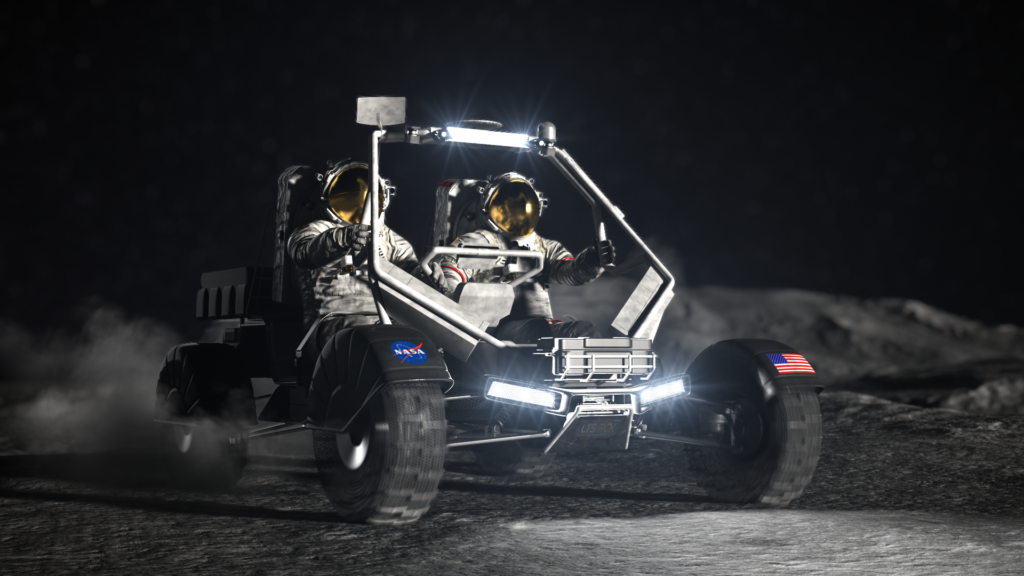News
Title: NASA Selects Intuitive Machines, Lunar Outpost, and Venturi Astrolab to Drive Lunar Mobility for Artemis Missions
NASA selects Intuitive Machines, Lunar Outpost, and Venturi Astrolab to advance lunar mobility for Artemis missions. Lunar terrain vehicle development begins! 🚀🌕 #NASA #Artemis #MoonExploration

NASA’s Artemis program is set to make history by returning humans to the Moon and paving the way for future missions to Mars. In a significant step towards this ambitious goal, NASA has chosen three companies – Intuitive Machines, Lunar Outpost, and Venturi Astrolab – to advance the development of a lunar terrain vehicle (LTV). This vehicle will enable astronauts to traverse the lunar surface, conduct scientific research, and prepare for upcoming Artemis missions.
Advancing Lunar Exploration:
The selection of Intuitive Machines, Lunar Outpost, and Venturi Astrolab underscores NASA’s commitment to leverage private-sector expertise to enhance lunar capabilities. By partnering with these companies, NASA aims to combine its own rovers’ development experience with commercial innovation, ultimately advancing scientific discovery and long-term human exploration on the Moon.
Key Milestones and Contract Details:
The Lunar Terrain Vehicle Services contract, with a combined maximum value of $4.6 billion, will be delivered to the selected companies as a service from the industry. Each provider will start with a one-year feasibility study to develop a system that meets NASA’s requirements. This study will be followed by a task order proposal, where eligible providers will showcase a demonstration mission to test the LTV’s performance and safety ahead of Artemis V.

Features and Capabilities:
The LTV will be purpose-built to withstand the extreme conditions at the Moon’s South Pole, offering advanced technologies such as power management, autonomous driving, and state-of-the-art communication and navigation systems. Its capabilities will enable astronauts to explore, transport scientific equipment, and collect lunar surface samples. The LTV’s extended range will significantly enhance scientific returns by allowing astronauts to access locations that would be unreachable on foot alone.
A Partnership for Science and Discovery:
Aside from the Artemis missions, the LTV will continue operating remotely to support NASA’s scientific objectives on the Moon. During these periods, the provider will also have the opportunity to utilize the LTV for commercial lunar activities unrelated to NASA missions. This public-private partnership demonstrates NASA’s commitment to expanding lunar exploration beyond government-funded initiatives.
Looking Towards the Future:
Through the Artemis program, NASA plans to send astronauts, including the first woman and the first person of color, to explore the Moon. This undertaking aims to unlock scientific discoveries, drive technological advancements, create economic benefits, and lay the groundwork for future crewed missions to Mars. Alongside advanced rovers, the Space Launch System (SLS) rocket and the Orion spacecraft, as well as commercial human landing systems, the LTV serves as a cornerstone for NASA’s ambitious deep space exploration plans.
By strategically partnering with Intuitive Machines, Lunar Outpost, and Venturi Astrolab, NASA is taking significant steps towards the realization of its Artemis program objectives. The development of the lunar terrain vehicle will empower astronauts to explore and conduct vital scientific research on the Moon’s surface, paving the way for humanity’s continued exploration of space. With these advancements, NASA is propelling us towards a future where humankind will make remarkable discoveries and eventually set foot on Mars.
NASA
Learn more about NASA’s Artemis campaign at:
What is the Artemis Program?
The Artemis program, led by NASA, is a program dedicated to exploring the Moon. It was established in 2017 through Space Policy Directive 1. The program aims to establish a human presence on the Moon for the first time since Apollo 17 in 1972. The long-term goal of the program is to establish a permanent base on the Moon, which will facilitate human missions to Mars.
The Artemis program has two main components that were originally part of the now-cancelled Constellation program: the Orion spacecraft and the Space Launch System, which is a reincarnation of Ares V. Other parts of the program, such as the development of the Lunar Gateway space station and the Human Landing System, are being carried out by both government space agencies and private spaceflight companies. The Artemis Accords and governmental contracts bind all these efforts together in a collaborative effort.
Artemis is a spaceflight program that involves the Space Launch System, Orion spacecraft, and the Human Landing System. The Lunar Gateway is also part of the program and supports human habitation. Additionally, there are supporting infrastructures such as Commercial Lunar Payload Services, VIPER rover, development of ground infrastructure, Artemis Base Camp on the Moon, Moon rovers, and spacesuits. However, some aspects of the program have been criticized, such as the use of the near-rectilinear halo orbit and the sustainability of the space program.
Orion’s first launch on the Space Launch System was originally scheduled for 2016. However, it was rescheduled and finally launched on 16th November 2022 as the Artemis 1 mission. The spacecraft carried robots and mannequins onboard. Artemis 2, the next crewed mission, is planned to launch in late 2025. Artemis 3, which will involve a crewed lunar landing, is scheduled for 2026. The Artemis 4 mission will involve docking with the Lunar Gateway in 2028. After that, yearly landings on the Moon are planned. (Wikipedia)